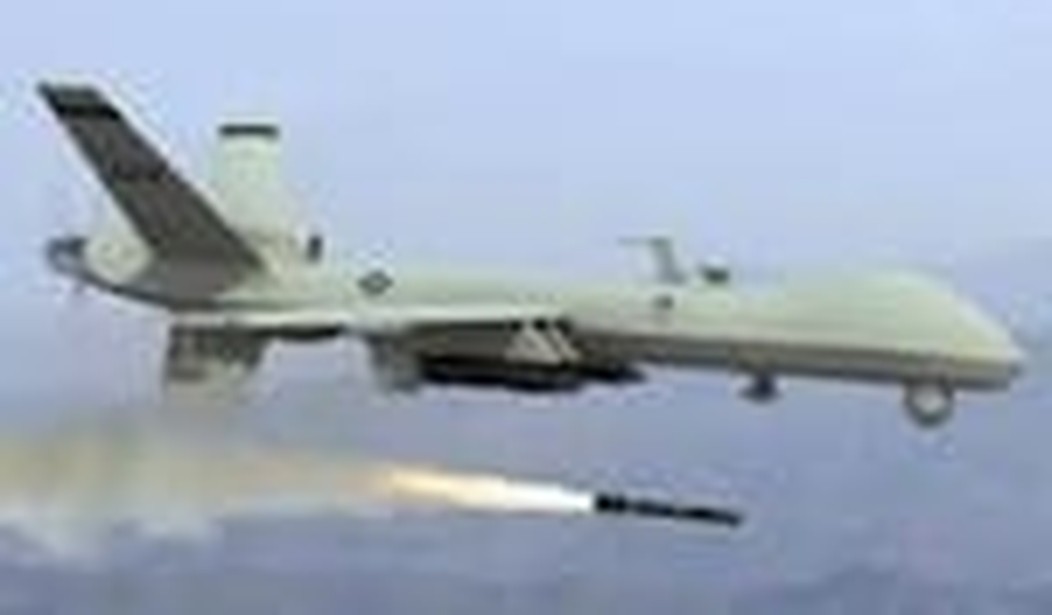There is no good U.S. policy for the civil war taking place in Syria. The victory of either side would be bad for U.S. interests and values. And none of the contestants are likely to be good for the Syrian people. However, there is a lot of pressure on the U.S. to “do something” because of the number of people being killed. And the fall of the Assad government would deal a highly desirable blow to the revolutionary regime of Iran.
It is technically possible to use unmanned aircraft (drones) equipped with Hellfire missiles to largely prevent tanks or heavy artillery from being used in the conflict.
The big advantage of this possible policy is that it does not require supporting or interacting with any of the groups fighting the Syrian government (and in some cases each other). It is an action that weakens the Syrian government because it is the only combatant using tanks and heavy artillery, but it doesn’t strengthen any particular opposition force. Therefore the U.S. and its partners would have only limited or indirect responsibility for the crimes of groups that might gain power as a result of the weakening of Assad’s government.
Other countries could operate and control many of the drones, so that the program could be international rather than purely American.
The policy also has the advantage of not bringing any weapons into the country which could later be used in other conflicts, and it is not likely to cause substantial casualties to Americans or others who participate in the drone program to suppress tanks and artillery.
There are two ways such anti-armor drones could be protected from the Syrian air force. One possibility would be to warn the Syrians that if they try to shoot down the drones, their air force would be attacked and severely degraded. The other possibility would be to cripple the Syrian air force by attacks from the air.
The U.S. Defense Department has stated that the destruction of the Syrian air force or the enforcement of a complete no-fly zone would require a very large, expensive, and possibly dangerous military effort. However, a thoughtful, well-informed study by the Institute for the Study of War reviewed by retired General Jack Keane concluded as follows:
The Syrian air force (SAF) is highly vulnerable to a limited strike against bases and planes from the U.S. Navy and Air Force using precision-guided munitions (PGM). That limited strike would:
• Take place from beyond the effective range of the Syrian Integrated Air Defense System (IADS)
• Place no U.S. personnel at risk
• Be accomplished at very low cost
Such a limited strike would result in a significant reduction in the SAF ability to
• Conduct aerial bombardment of rebel forces, or to
• Receive aerial resupply from Russia and Iran, or to
• Conduct aerial resupply of Syrian Arab Army
Using drones against Syrian armor would be a weaker policy than the proposal to enforce a no-fly zone to protect the opposition from the Syrian air force. But it has the advantage of less cost and less risk to American lives. In other words, if the U.S. wants to act against the Assad regime with limited attachment to any opposition group, it can act either against his tanks and artillery, or against his air force, or against both.
It is possible that such an international intervention against tanks and artillery would reduce casualties and lead to an improved outcome for Syrian citizens and neighboring countries, but it might also make things worse.
Since almost all the major forces in Syria are murderous and cruel as well as enemies of the U.S. and the West, this intervention is not likely to produce a favorable outcome. But there is no other policy which can be expected to produce a better outcome. This kind of intervention would probably increase the chance that Assad’s government would be defeated — he has been such a murderous tyrant that his defeat would be just. Also, his defeat would be a serious blow to the power of the revolutionary government of Iran.
If Assad is defeated, the ultimate victor is likely to be one or more radical Sunni Islamist group (possibly after a long period of disorder). The record and ideology of all of these groups makes it likely that they would oppress or kill Christian, Shia, Alawite, Kurdish, and Druze populations of Syria, and force religious behavior on secular citizens. This is the reason why the Syrian minorities have not given much support to Assad’s opponents.
The advantage of the intervention described here is that it would increase the chance of a major defeat for the revolutionary regime in Iran. Also, the U.S. and the West would not be idle during a civil war that has already produced approximately 100,000 deaths, millions of refugees, and great destruction of property and economic production. It is difficult to imagine another substantial outside intervention that would not stand a good chance of being more harmful than the options proposed here.
Also read: U.S. Naval Forces Moving Toward Syria









Join the conversation as a VIP Member